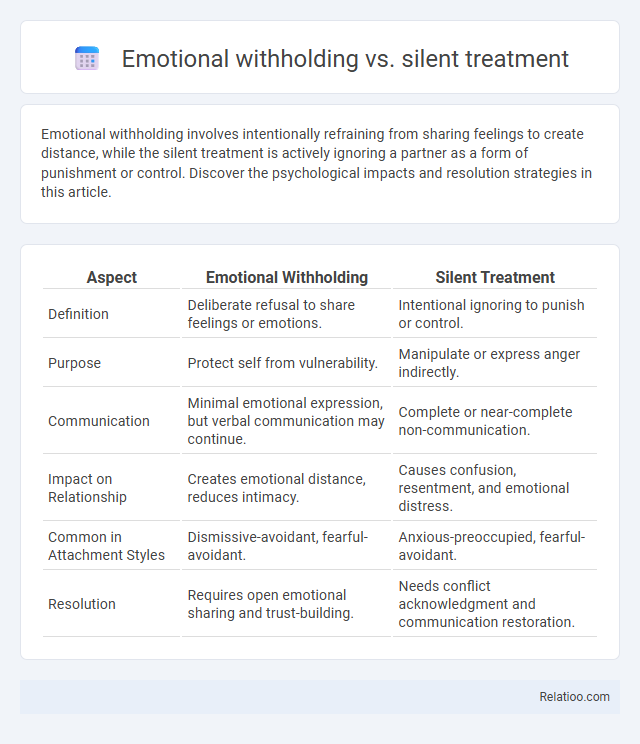Emotional withholding involves intentionally refraining from sharing feelings to create distance, while the silent treatment is actively ignoring a partner as a form of punishment or control. Discover the psychological impacts and resolution strategies in this article.
Table of Comparison
| Aspect | Emotional Withholding | Silent Treatment |
|---|---|---|
| Definition | Deliberate refusal to share feelings or emotions. | Intentional ignoring to punish or control. |
| Purpose | Protect self from vulnerability. | Manipulate or express anger indirectly. |
| Communication | Minimal emotional expression, but verbal communication may continue. | Complete or near-complete non-communication. |
| Impact on Relationship | Creates emotional distance, reduces intimacy. | Causes confusion, resentment, and emotional distress. |
| Common in Attachment Styles | Dismissive-avoidant, fearful-avoidant. | Anxious-preoccupied, fearful-avoidant. |
| Resolution | Requires open emotional sharing and trust-building. | Needs conflict acknowledgment and communication restoration. |
Understanding Emotional Withholding: Definition and Signs
Emotional withholding involves deliberately suppressing feelings, creating emotional distance that hinders genuine connection and communication. Signs include avoiding eye contact, giving short or vague responses, and refusing to share thoughts or feelings during conflicts, which can deeply affect Your relationships. Recognizing these behaviors is crucial for addressing emotional barriers and fostering healthier interactions.
What Is Silent Treatment? Key Characteristics Explained
The silent treatment is a form of emotional manipulation where one person deliberately refuses to communicate, creating a barrier to resolving conflicts. Key characteristics include purposeful ignoring, withholding verbal responses, and using silence as a tool to punish or control. This behavior differs from general emotional withholding, which may involve subtle avoidance of sharing feelings rather than complete communication blackout.
Emotional Withholding vs Silent Treatment: Core Differences
Emotional withholding involves deliberately suppressing feelings and affection as a form of control or self-protection, whereas silent treatment is an active refusal to communicate, often used to punish or manipulate. You may experience emotional withholding as a quiet barrier to intimacy, while the silent treatment creates a palpable silence that forces confrontation. Understanding these core differences helps identify unhealthy communication patterns to foster healthier emotional connections.
Psychological Impact on Relationships
Emotional withholding, silent treatment, and emotional neglect each create distinct psychological impacts that undermine trust and intimacy in relationships. Emotional withholding involves consciously suppressing feelings, leading to emotional distance and partner confusion, while silent treatment takes this further by using intentional silence as a form of punishment, causing anxiety, resentment, and emotional pain. These behaviors damage communication patterns, foster insecurity, and can lead to long-term emotional withdrawal or relationship breakdown.
Common Triggers and Underlying Motivations
Emotional withholding, silent treatment, and emotional withholding often stem from fears of vulnerability, unresolved conflicts, or a need for control. Common triggers include feelings of rejection, perceived criticism, and unmet emotional needs that prompt individuals to shut down communication as a defense mechanism. Underlying motivations frequently involve protecting oneself from further emotional pain, exerting power in a relationship, or expressing dissatisfaction indirectly.
Identifying Patterns of Emotional Manipulation
Emotional withholding, silent treatment, and similar behaviors are key patterns of emotional manipulation that deliberately create distance and confusion in relationships. Your awareness of these tactics, such as refusing to communicate feelings or ignoring your emotional needs, is crucial for identifying manipulation early. Recognizing these patterns empowers you to set healthy boundaries and protect your emotional well-being.
Communication Breakdown: Emotional Withholding vs Silent Treatment
Emotional withholding involves deliberately suppressing feelings and thoughts, creating a barrier to open communication that fosters misunderstanding and resentment. The silent treatment is a more overt form of communication breakdown, where one partner intentionally refuses to speak, escalating tension and prolonging conflict. Both behaviors disrupt healthy dialogue, but emotional withholding subtly erodes trust, while the silent treatment actively shuts down conversation, intensifying emotional distance.
Recognizing Emotional Abuse in Subtle Forms
Emotional withholding, silent treatment, and emotional neglect are subtle forms of emotional abuse that undermine trust and connection in relationships. Recognizing these behaviors involves identifying consistent patterns of ignoring, refusing communication, or withholding affection and validation to manipulate or punish a partner. Awareness of these nuanced tactics helps individuals protect their emotional well-being and seek healthier relationship dynamics.
Healthy Responses and Coping Strategies
Emotional withholding involves consciously choosing to not express feelings, often as a protective mechanism, while silent treatment is a punitive response aimed at controlling or punishing a partner. Healthy responses include open communication, expressing emotions respectfully, and establishing boundaries without resorting to silence or avoidance. Effective coping strategies involve self-reflection, seeking therapy, practicing mindfulness, and fostering empathy to promote emotional connection and conflict resolution.
Steps for Healing and Restoring Trust
Healing from emotional withholding and silent treatment requires consistent open communication and genuine empathy to rebuild trust and emotional safety. Establishing clear boundaries, practicing active listening, and engaging in vulnerability exercises promote mutual understanding and emotional connection. Professional counseling or therapy often supports the restoration process by addressing underlying issues and fostering healthier relational patterns.

Infographic: Emotional Withholding vs Silent Treatment
 relatioo.com
relatioo.com